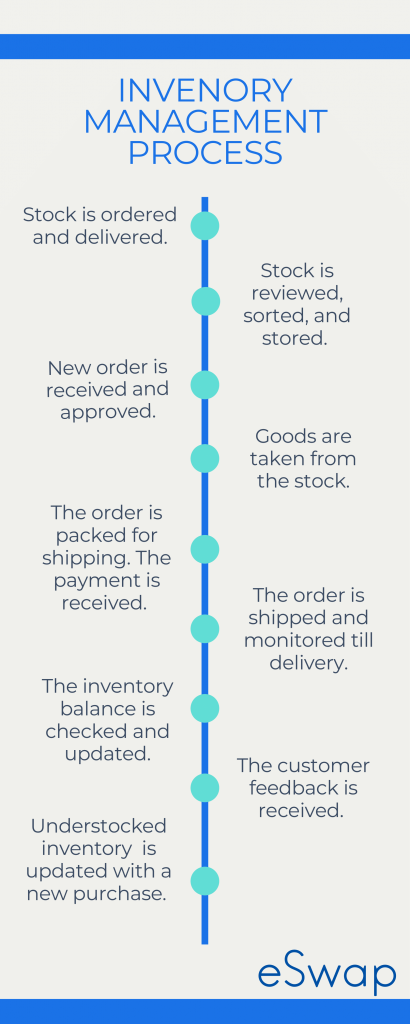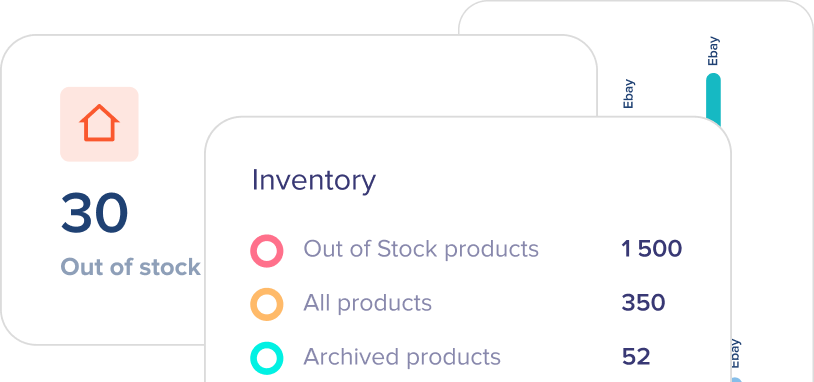As Investopedia defines, the term inventory is used to describe goods and raw materials available for sale or available to be used to produce goods for sale. It is of the most crucial assets that a company holds for two main reasons. First, for retail and wholesale businesses, it usually is the asset of the highest value. Second, because inventory turnover is one of the key sources of revenue generation for the company.

Inventory vs. stock
In the daily operations of a retail business, inventory is frequently referred to as “stock.” Many use those two terms interchangeably. However, there are some slight differences.
Context: Inventory is mainly used in the accounting context, while stock is used in business talks.
Valuation method: Inventory is valued by FIFO, LIFO, or Average Weighted Cost methods. On the other hand, the product’s market value is used for stock valuation, which is the price at which it is sold to the customers.
Valuation frequency: Inventory valuation is only conducted once at the end of the financial year for reporting purposes. Companies should value stock frequently, sometimes even daily.
What is inventory management?
It is an important process in supply chain management that is responsible for tracking and controlling quantities in and out of the warehouse.
The primary goal of an inventory management system is to know the location and quantities of inventory at any given time. So, nowadays, companies integrate information technologies in management practices such as barcode scanning and managerial software to increase the efficiency and accuracy of the control systems.
Why is it critical?
Inventory management has central importance, especially for companies operating in inventory-intensive industries. Without an adequately managed inventory, the rest of the supply chain activities will fall out of place. Common issues that will arise are wrong shipments, stockouts, and overstocking, etc. As a result, the company will have wasted resources, unsatisfied customers, and lost profits.
What are the benefits of inventory management?
The primary issue that inventory management solves is to ensure that you can fulfill customer orders and increase profits. Other than that, it also provides the following benefits:
Improved accuracy and efficiencies
As the research suggests, for retail businesses, the inventory accuracy is only 63%. Considering the issues and damages that its inaccuracy creates, this number is very high. The order and on-hand stock accuracy increase with proper inventory tracking and control.
Cost-saving
Improved accuracy means fewer errors to fix, which means there is less expenditure required for fixation. Well-managed inventory also saves money on holding unnecessarily high levels of items because the company will have just adequate levels of stock and renew it upon requirement.
Avoids stockouts and over stockings
One of the most crucial issues for a retail and wholesale business is to have the correct volumes. Without continuous and proper tracking, there is a risk of excess or lack of required stock volumes. Both of those cases are bad. When a company does not have enough inventory, it cannot meet demands and lose customers and profits. On the other hand, when there are excess levels of products, the handling costs increase, and the opportunity costs come out.
Improved customer service
Businesses in every industry nowadays have a big customer orientation. Satisfied and happy customers are one of the key targets. First, because it is essential to reach their loyalty, it is also vital for reviews and reputation.
Efficient inventory management leads to accurate and timely fulfillment of customers’ orders. When a customer gets the right product in the right place at the right time without any complications, they feel satisfied with their experience and will be willing to return.
Process
Inventory management processes can alter depending on business models. However, there are general patterns that those process cycle go through.

Frequently Asked Questions
How do you estimate if your inventory management is successful?
Numbers are the best proof of your progress. When you integrate a new management system or update your practices and techniques, compare the before and after data.
For example, you can review the numbers of mis-picks, mis-shipments, stockouts, obsolescence levels, etc. Another indicator is the good reviews from customers.
Who should be accountable for inventory management effectiveness?
It is unreasonable to assume that there can be only one person responsible for its effectiveness. Almost everyone in a company is directly or indirectly involved in this process. For example, the procurement department has to ensure well-organized purchasing to avoid over or under-stockings. The warehousing team is responsible for handling all inventory and adequately managing the warehouse to prevent unnecessary handling costs and spendings. They are also responsible for accurately picking, packing, and shipping customer orders.
The integration of eSwap will strongly improve the effectiveness of inventory management. It offers features that can make everyone’s job involved in management processes more effective and efficient:
How to prepare for peak seasons?
Although the peak seasons, such as holidays or special events, are stressful and busy for business operations, these are the times when companies generate huge profits. So, to enjoy the benefits, it is essential to have proper inventory management in place.
Before entering into the peak season, here are some things you can do:
- Conduct interim inventory counts to ensure the correctness of volumes.
- Ensure you have an adequate level of shipping supplies available for use.
- Consider hiring temporary staff to be ready to handle high levels of orders efficiently.
- Make sure to organize warehouse so that everything is in its proper location.
- Implement a software system to improve your order management. It will help to increase accuracy and save time.







